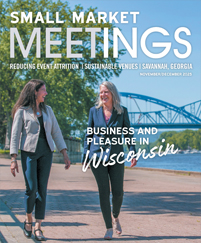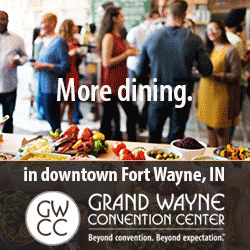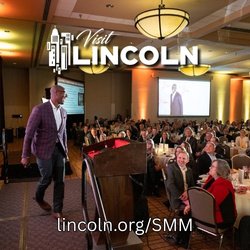Illinois is rich in Civil War history but is also famous for its connection to Abraham Lincoln. Groups that want to incorporate a bit of history into their meetings or conferences can plan events at historic sites around the state. From mansions and a Swedish communal colony to a living-history museum and the Old State Capitol in Springfield, there are many options from which to choose.
Governor Oglesby Mansion
Decatur
Meeting planners can capture a unique part of U.S. history by renting out the Governor Oglesby Mansion in Decatur. The home was built by Richard Oglesby, a jack-of-all-trades who ended up becoming one of the most prominent men in Illinois. He not only served as a U.S. senator, a brigadier general in the Union Army during the Civil War and governor of Illinois three times, but also counted Lincoln and Ulysses S. Grant as close personal friends.
The Oglesby mansion was built in 1873 as an addition to the Oglesby’s original residence. The old part of the house became the kitchen and servants’ living quarters. The Oglesby family lived in the Decatur mansion until 1882, when it was sold to another family who lived in it until 1972. The Macon County Conservation District took over restoring the property in 1976. The house is open for tours, and its claim to fame is that President Grant visited Oglesby there. The home is full of period pieces from the mid- to late 1800s, including Mexican president General Santa Anna’s cork leg that was confiscated during the Mexican-American War.
Meeting groups can soak up the history of the mansion by hosting an event in the large dining room, which can hold 75 guests for receptions and 46 for sit-down meals. Attendees can tour the home with a docent as part of their event.
Bishop Hill State Historic Site
Bishop Hill
Bishop Hill was a colony founded by followers of Erik Janson, a religious leader in Sweden who came into conflict with the state Lutheran Church because of his unusual theology. Between 1846 and 1861, about 1,200 of his followers came from Sweden to Illinois. The colony lasted only 15 years before it was dissolved, but it was the catalyst for a mass migration of people from Sweden to the United States. Fourteen of the original buildings from the colony have been preserved by numerous groups, and many spaces are available for meetings or events.
The Dairy Building is the largest event space on the historic site. The remodeled 1855 brick building is used for weddings, meetings and reunions. The space can hold up to 75 people for a seated gathering. The Steeple Building museum can hold smaller groups of about 40 people. Groups that book the Steeple Building can wander the museum to see two floors of artifacts and exhibits that date back to the 19th century. The Colony School is twice the size of the Dairy Building and is used for larger events. Outdoor spaces are available as well.
“We have a lot of colony descendants in the area who live in Bishop Hill and the surrounding communities,” said Todd DeDecker, administrator for the Bishop Hill Heritage Association. There are 18 pre-Civil War buildings still in use today in Bishop Hill and six museums in the town of 125 people.
Evanston History Center at the Charles Gates Dawes House
Evanston
Charles Dawes served as vice president of the United States under Calvin Coolidge. Not only was his great-grandfather Paul Revere but Dawes had an incredible political career, working for five U.S. presidents. He received the Nobel Peace Prize in 1925 for helping to reduce tensions between France and Germany after World War I.
His home is now a history museum stocked with original furnishings, including Tiffany lamps and oil paintings. Groups of 150 people can rent out the mansion, which was built from 1894 to 1895 in the French Chateau style.
When groups host meetings there, “it takes them out of their everyday and permits them to think on a larger scale and think more holistically, and it is just a beautiful environment to be in,” said Kris Hartzell, director of facilities, visitor services and collections for the Evanston History Center at the Charles Gates Dawes House. There are two rooms that can be used for meetings. The east parlor is “lighter and brighter and smaller, and the great hall is very impressive and better for larger groups,” she said. The parlor can hold up to 40 people, and the great hall can hold up to 80 people. The outside terrace is also available for meals or receptions. During breaks, meeting attendees can visit the exhibits or have a drink on the terrace overlooking the lake.
Naper Settlement
Naperville
The Naper Settlement is a 19th-century living-history museum that demonstrates what life was like in northern Illinois and Naperville during that period. Costumed interpreters lead tours through 30 historic buildings that were relocated to the grounds since the settlement was established in 1969. The settlement got its start when a group of individuals set out to save a Civil War-era church from demolition. They raised funds to have the church transferred to the grounds of the Martin Mitchell Mansion.
The Victorian mansion, which was built in 1883, and the carriage house are the only original buildings on the property.
“The entire 13 acres feels more like a park with lots of gardens,” said Adison Glick, special events team leader for the Naper Settlement.
Meeting planners can use both indoor and outdoor rental spaces at the settlement, including the Century Memorial Chapel and Century Heritage Hall, the Meeting House and the Pre-Emption House Tavern. The chapel, which was built in 1864, can hold groups of 175 people, and Heritage Hall, in the basement of the church, has a catering prep kitchen, which makes it a great space for receptions and business meetings. The meeting house, built in 1841, can host groups of 100 people. The tavern, built in 1834, is a much smaller venue for groups of up to 45 people.
In downtown Naperville, right next to the Riverwalk that runs along the DuPage River, the site is perfect for outdoor festivals, concerts and holiday events.
Old State Capitol
Springfield
Built between 1837 and 1840, Illinois’ Old State Capitol is one of the most iconic buildings in Illinois because of its connection to Lincoln. The building served as the Illinois statehouse from 1840 to 1876. Lincoln served his last year as a state lawmaker in the building, and he famously gave his “house divided against itself cannot stand” speech in 1858 when he announced his candidacy for the U.S. Senate.
Even though the new state capitol is only blocks away, the Old State Capitol captures the most attention.
“It’s the most photographed building in town because of its historic nature, but also, up against modern architecture, it just stands out,” said Justin Blandford, superintendent of State Historic Site at Springfield. The two-story Greek Revival structure is a beautiful orange sandstone color, which sets it apart from its brick neighbors.
Meeting planners are attracted to the building because it is one of the few downtown venues large enough to host big groups and because it has such historical significance that attendees feel honored to be there.
Groups can rent Foundation Hall, which is a large modern hall that can seat up to 90 people and has all the modern amenities, including a 10-foot screen and a projector. Representative Hall, where Lincoln gave his historic speech, is the largest space and can easily host evening receptions for up to 220 people.












